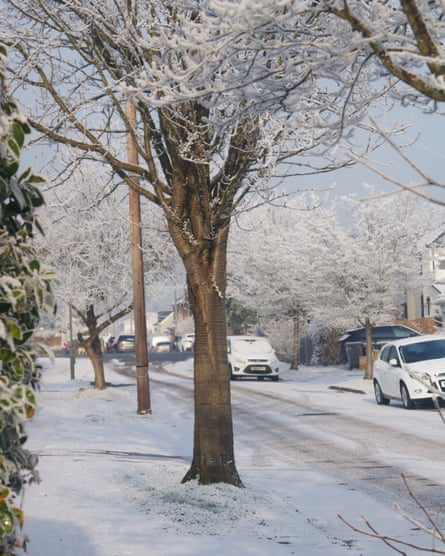An unusual occurrence of “industrial snowfall” believed to be linked to pollution has been documented in the UK.
According to a research, a unique occurrence called “industrial snowfall” was observed near Heathrow airport earlier this year.
Satellite pictures reveal three prominent, pale stripes on the terrain in certain areas of Surrey despite relatively parched weather conditions in the region during the time of recording. The snow, documented on 23 January, was found near industrial buildings to the south-east of Heathrow airport.
According to Dr. Julian Mayes, a weather and climate consultant who witnessed the snow and conducted a study, the primary cause of the snowfall was pollution.
Snowfall caused by human activities or industries can happen when water vapor in the air gathers around small particles of pollution, resulting in the formation of snowflakes. This requires specific conditions, including low temperatures and a high level of moisture in the air. There have only been a few instances of this occurring in the UK.
Mayes described a chilly morning in West Molesey, Surrey where freezing fog had covered the village. He realized that it was more than just frost.

After examining more closely, he discovered that the snow was extremely dry, resembling “dehydrated coconut,” and seemed to have fallen onto surfaces from above, unlike frost. Mayes found this confusing at first, as the region was experiencing high pressure and no precipitation was forecasted at the time.
A coworker informed him about a satellite photo of eastern Surrey captured on January 23rd, showing three areas that appeared to have light snow. Mayes theorized that a soft wind had carried the snow from industrial sites to the north-northwest, leaving it in these patterns.
According to Prof Giles Harrison, a meteorology expert from the University of Reading, the satellite image displayed a small amount of drifting clouds. However, it is highly improbable that the snow was produced by these clouds in the usual way. There was no sign of a weather front moving through the region, which typically causes regular snowfall. This statement was made independently, as Prof Harrison was not involved in the research.
Other factors, aside from industrial pollution from the ground, could have played a role in the events of that day, according to Mayes. These could include possible trails of ice created by planes taking off and landing at the airport, as well as moisture from nearby reservoirs.
However, he stated that the proof suggested that there was a factor causing water droplets in the fog to grow and freeze, resulting in snowflakes. It is believed that pollution may have served as footholds, or nucleation sites, for the droplets to transform into ice crystals.
“It’s quite unique,” stated Harrison, one of the authors of a 2009 research on previous cases of industrial snowfall in the UK. One of these instances was linked to emissions from a cider factory. A resident in the area was quoted in the study as saying, “There was a light dusting of snow, and it had a slight apple taste.”
Harrison stated that observers may have been surprised by the unexpected occurrence of industrial snowfall, as it was not usually predicted.
The occurrence has also been documented in the United States. In 2014, there was one reported incident in Amarillo, Texas, which was attributed to steam from large power plants, believed to have transformed into snow in the chilly February weather. A representative from a local energy company shared with the Amarillo Globe-News that their employees had observed this phenomenon for many years.
Harrison stated that this unique type of snow would likely become even less common in the UK. This is due to the projected increase in average temperatures caused by global warming.
Mayes stated that he came across the phenomenon purely by chance, as the snowfall was limited to a small area. He added, “If I had been living just a mile and a half away, I likely would not have noticed it.”
Source: theguardian.com


